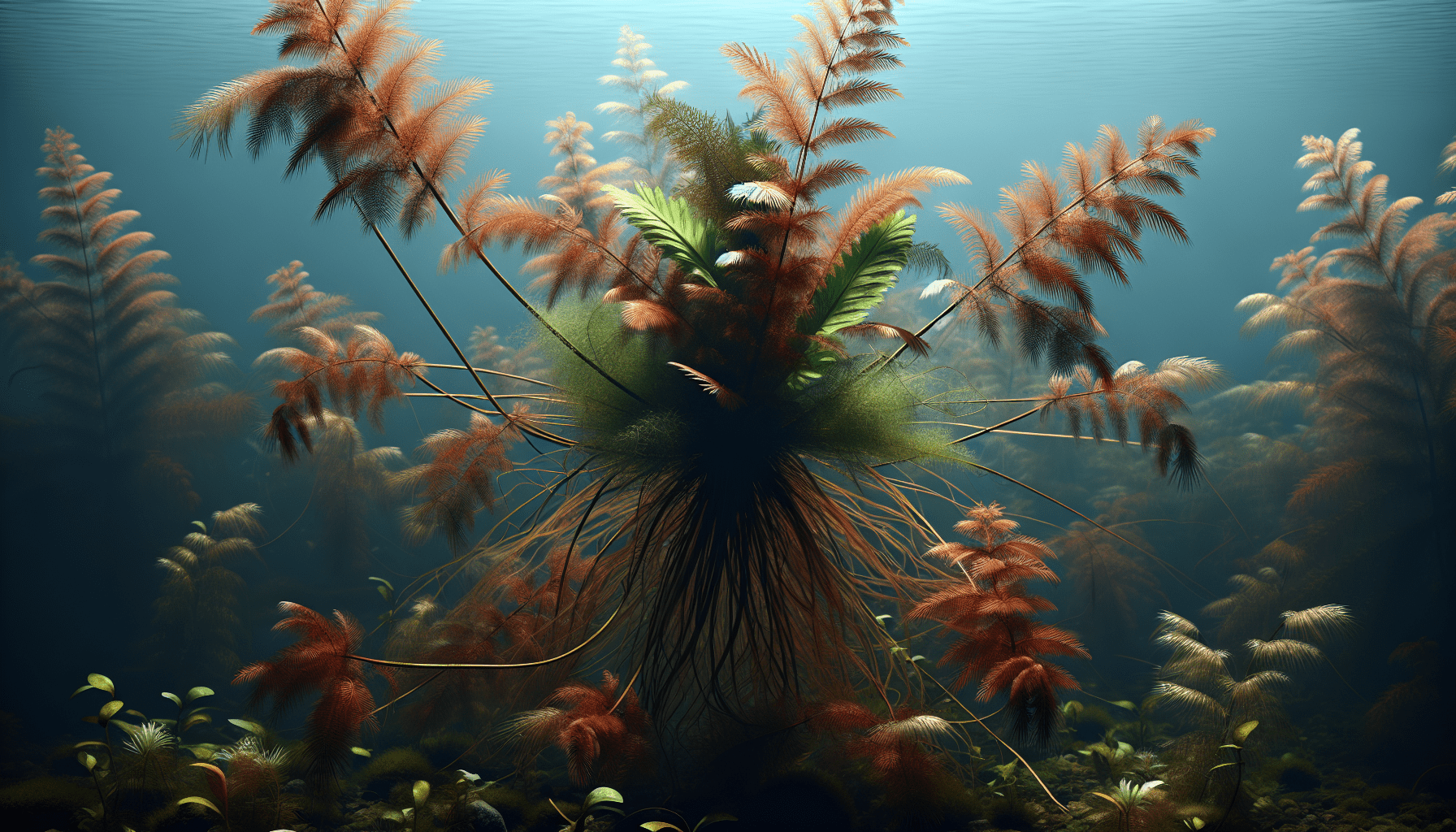Cabomba Furcata, a distinct aquatic weed, may arouse your curiosity due to its unique attributes. This article provides an insightful analysis of Cabomba Furcata, shedding light on its origin, biological characteristics, habitat, and its role in the ecosystem. It seeks to enlighten you on why this specific aquatic weed stands out among numerous other aquatic plants, backed by empirical findings and expert assessments. Furthermore, it highlights potential ways in which Cabomba Furcata may affect or interact with its surroundings—information that could serve vital to those involved in aquaculture, aquatic life conservation, or simply anyone with an interest in exploring nature’s nuances.
Overview of Cabomba Furcata
Cabomba Furcata, commonly referred to as the Red Cabomba or the Forked Fanwort, is a perennial, rooted, aquatic plant often found in fresh water bodies. Known for its radiant coloration and intricate leaf structure, this plant species has recently gained attention in both the academic world and aquarium trade.
Definition of Cabomba Furcata
Cabomba Furcata is a flowering plant which, unlike most terrestrial plants, is found primarily in aquatic environments. The plant belongs to the family Cabombaceae and achieves its latinized moniker from its distinctive nature – ‘furcata’, implying ‘forked’, is an apt descriptor of the bi-pinnate leaves that are a hallmark of this species.
Classification and Taxonomy
In terms of taxonomy, the Cabomba Furcata belongs to the Kingdom Plantae, which encompasses all plants. Further down in the hierarchy, it falls into the Cabombaceae family and is part of the genus Cabomba, which is characterized by aquatic plants exhibiting the unique fan-like leaf structure. The species name “furcata” refers to this plant’s distinctive forked leaf pattern.
Geographical Distribution
Originally, Cabomba Furcata’s natural distribution included moderate to tropical regions of North and South America. However, it has since spread to other parts of the world due to the aquarium trade. The plant thrives in freshwater bodies such as ponds, lakes, and slow-moving rivers.
Characteristics of Cabomba Furcata
This plant is not just visually striking because of its vivid red and purple hues but is also notable for its resilience in a variety of aquatic environments. Understanding its physical characteristics and life cycle is crucial for both researchers and aquarium hobbyists alike.
Physical Properties and Appearance
Cabomba Furcata is distinguishable by its finely divided, fan-shaped leaves that often range from red to purple in color. The plants can grow up to 80 cm and the leaves, growing opposite each other along a central stem, help the plant float in water.
Adaptations to Aquatic Environment
In terms of survival mechanisms, Cabomba Furcata is a versatile and adaptable plant. It has developed several adaptations to aquatic living, including a stem that can store air, helping the plant survive in both low light and low nutrient conditions.
Growth and Development
The growth rate of Cabomba Furcata varies depending on the specific conditions of the aquatic environment. With sufficient light and nutrients, it is known to grow rapidly and can quickly cover a large area.
Reproduction and Propagation
The reproductive process of Cabomba Furcata is twofold, involving both the production of seeds and asexual reproduction through stem fragmentation. The latter method is particularly significant, as the plant can regenerate from fragments, which contributes to its potential invasiveness.

Ecological Role and Importance
Although often denounced as a weed, Cabomba Furcata plays a vital role in the ecology of aquatic environments. This includes its contributions to biodiversity and its interactions with other aquatic organisms.
Role in Aquatic Ecosystems
In aquatic ecosystems, Cabomba Furcata provides an essential habitat for various invertebrates and fish species, owing to its dense growth and extensive spread. It also contributes to oxygen production through photosynthesis and aids in stabilizing sediment and preventing erosion.
Interactions with other Aquatic Organisms
Cabomba Furcata interacts with a variety of aquatic organisms in the ecosystem. Its thick foliage serves as a refuge for small aquatic animals and offers ideal breeding grounds for specific fish species. However, dense growth can also outcompete native species for sunlight, nutrients, and space.
Contribution to Biodiversity
Despite its weed status in certain regions, Cabomba Furcata contributes significantly to biodiversity in aquatic ecosystems. Its presence can boost the variety of organisms present in an area and add to the overall health and equilibrium of an ecosystem.
Cabomba Furcata’s Use in Aquariums
Despite potential issues associated with overgrowth, Cabomba Furcata is a popular choice in the aquarium trade due to its aesthetic appeal and benefits for aquatic life in tanks.
Benefits for Aquatic Life in Tanks
In aquariums, Cabomba Furcata provides a similar ecosystem function as it does in the wild. It serves as habitat and spawning ground for fish species, contributes to oxygen levels, and improves water quality by absorbing excess nutrients.
Maintenance and Care Requirements
Maintaining a healthy Cabomba Furcata plant in an aquarium requires a delicate balance of light, nutrient availability, and water temperature. The plant requires ample lighting and nutrient-rich substrate to thrive, and fares best in temperatures ranging from 72 – 82 °F.
Compatibility with other Aquic Plants
Cabomba Furcata generally coexists well with other aquatic plants in aquarium settings. However, due to its rapid growth, steps must be taken to ensure it does not crowd out other species.

Potential Challenges with Cabomba Furcata
Despite its ecological benefits and aesthetic appeal, Cabomba Furcata can pose significant challenges, namely issues related to overgrowth, impacts on water quality, and its potential to behave as an invasive species.
Issues with Overgrowth
The fast-growing nature of Cabomba Furcata can lead to overgrowth, especially in nutrient-rich, light-saturated conditions. This can result in this plant crowding out other species and disrupting the balance of ecosystems, both natural and manmade.
Implications for Water Quality
Excessive growth of Cabomba Furcata can cause problems with water quality. When the plant dies and decomposes, it can deplete oxygen levels in the water. This can adversely affect other aquatic life and result in unpleasant odors.
Potential for Invasive Behavior
Due to its rapid growth and ability to propagate from fragments, Cabomba Furcata is considered a potential invasive species in some regions. It can quickly take over new environments, especially in temperate to tropical climates, and outcompete native plants.
Control and Management of Cabomba Furcata
Owing to its potential challenges, effective control and management strategies are crucial when dealing with Cabomba Furcata, including physical removal, chemical control, biological control, and preventive measures.
Physical Removal Methods
One of the most common ways to control Cabomba Furcata is through physical removal. This involves manually or mechanically removing the plant from the water body. However, care must be taken to ensure all fragments are removed to prevent re-growth.
Chemical Control Strategies
Herbicides can be used to control Cabomba Furcata populations, though this method should be used with caution due to potential effects on non-target species and water quality.
Biological Control Options
Certain organisms, such as specific species of moths and weevils, have been identified as potential biological control agents for Cabomba Furcata. These species feed on the plant and can help keep its growth in check.
Preventive Measures
Preventive measures are key to managing Cabomba Furcata. This includes regular monitoring of water bodies, strict controls on the plant’s trade and transport, and public education on the potential impacts of this species.
Impacts of Cabomba Furcata on Human Activities
Cabomba Furcata’s rapid growth and extensive spread can affect various human activities. This includes impacts on water-based recreation, fishing, and infrastructure.
Effects on Water-Based Recreation
Dense mats of Cabomba Furcata can restrict access to water bodies and hinder water-based recreational activities such as swimming, boating, and canoeing.
Implications for Fishing
Tangled masses of Cabomba Furcata can impede fishing activities by snagging fishing lines and nets. Additionally, altered aquatic ecosystems owing to its invasiveness can potentially impact fish populations.
Impacts on Infrastructure
Cabomba Furcata can clog waterways and drainage systems, disrupting water flow and potentially damaging infrastructure.
Role of Cabomba Furcata in Scientific Research
Cabomba Furcata has significant value in the scientific community. Its unique characteristics make it an important subject of study in ecological research, genetic studies, and environmental education.
Usage in Ecological Studies
Cabomba Furcata serves as an important model organism in ecological studies, particularly in understanding aquatic ecosystems and dynamics of plant invasion.
Value for Genetic Research
Studies on the genetic makeup of Cabomba Furcata can provide insights into the evolutionary adaptations of aquatic plants and their responses to environmental changes.
Contribution to Environmental Education
Cabomba Furcata, with its potential advantages and challenges, serves a unique role in environmental education. It is a rich subject for teaching concepts about biodiversity, aquatic ecosystems, and invasive species management.
Legal and Regulatory Aspects
Given potential challenges posed by Cabomba Furcata, several countries have implemented legal regulations surrounding its cultivation, trade, and transportation.
Current Legal Status in Various Countries
In some jurisdictions, Cabomba Furcata is listed as a noxious weed due to its potential invasiveness. Trade and transportation may be regulated or outright prohibited in these regions.
Regulations Regarding Trading and Transportation
Many countries have regulations stipulating the sale, purchase, and transportation of Cabomba Furcata to prevent its unintentional introduction into new areas.
Efforts Towards Conservation and Management
Efforts are being directed towards the conservation and management of Cabomba Furcata. This includes regulating its spread, controlling its growth in invaded areas, and conserving native ecosystems.
Future Prospects of Cabomba Furcata
Cabomba Furcata presents exciting future prospects, particularly in terms of commercial use and research. However, environmental changes and associated challenges need to be taken into account.
Potential for Commercial Uses
Despite its invasive tendencies, Cabomba Furcata’s visual appeal provides significant potential for commercial use within controlled settings such as aquariums and ornamental ponds.
Opportunities for Research and Study
Cabomba Furcata is a remarkable plant with much still to learn about its ecological role, genetic make-up, and adaptive abilities. Future research into this area can yield beneficial results, enhancing our understanding of aquatic ecology.
Threats and Challenges due Environmental Changes
However, with changing environmental conditions, Cabomba Furcata may face significant challenges. Global warming may lead to shifts in its geographic distribution and invasive behaviors, leading potentially to larger issues in terms of biodiversity and ecosystem stability.
In conclusion, Cabomba Furcata bears significant ecological, commercial, and scientific value and yet, its potential as an invasive species also presents considerable challenges. Understanding and managing this dichotomy is crucial for the overall health of aquatic ecosystems and for continued human enjoyment and use of aquatic environments.